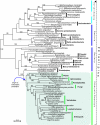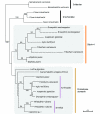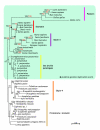Slipins: ancient origin, duplication and diversification of the stomatin protein family
- PMID: 18267007
- PMCID: PMC2258279
- DOI: 10.1186/1471-2148-8-44
Slipins: ancient origin, duplication and diversification of the stomatin protein family
Abstract
Background: Stomatin is a membrane protein that was first isolated from human red blood cells. Since then, a number of stomatin-like proteins have been identified in all three domains of life. The conservation among these proteins is remarkable, with bacterial and human homologs sharing 50 % identity. Despite being associated with a variety of diseases such as cancer, kidney failure and anaemia, precise functions of these proteins remain unclear.
Results: We have constructed a comprehensive phylogeny of all 'stomatin-like' sequences that share a 150 amino acid domain. We show these proteins comprise an ancient family that arose early in prokaryotic evolution, and we propose a new nomenclature that reflects their phylogeny, based on the name "slipin" (stomatin-like protein). Within prokaryotes there are two distinct subfamilies that account for the two different origins of the eight eukaryotic stomatin subfamilies, one of which gave rise to eukaryotic SLP-2, renamed here "paraslipin". This was apparently acquired through the mitochondrial endosymbiosis and is widely distributed amongst the major kingdoms. The other prokaryotic subfamily gave rise to the ancestor of the remaining seven eukaryotic subfamilies. The highly diverged "alloslipin" subfamily is represented only by fungal, viral and ciliate sequences. The remaining six subfamilies, collectively termed "slipins", are confined to metazoa. Protostome stomatin, as well as a newly reported arthropod subfamily slipin-4, are restricted to invertebrate groups, whilst slipin-1 (previously SLP-1) is present in nematodes and higher metazoa. In vertebrates, the stomatin family expanded considerably, with at least two duplication events giving rise to podocin and slipin-3 subfamilies (previously SLP-3), with the retained ancestral sequence giving rise to vertebrate stomatin.
Conclusion: Stomatin-like proteins have their origin in an ancient duplication event that occurred early on in the evolution of prokaryotes. By constructing a phylogeny of this family, we have identified and named a number of orthologous groups: these can now be used to infer function of stomatin subfamilies in a meaningful way.
Figures



 indicates the clade uniting Chlorobi, Gammaproteobacteria and Spirochetes with two parallel phylogenies. Note the position of Rickettsiales as the sister group to the eukaryotic clade. Accession numbers available in Additional file 2.
indicates the clade uniting Chlorobi, Gammaproteobacteria and Spirochetes with two parallel phylogenies. Note the position of Rickettsiales as the sister group to the eukaryotic clade. Accession numbers available in Additional file 2.



Similar articles
-
The NfeD protein family and its conserved gene neighbours throughout prokaryotes: functional implications for stomatin-like proteins.J Mol Evol. 2009 Dec;69(6):657-67. doi: 10.1007/s00239-009-9304-8. J Mol Evol. 2009. PMID: 20012272
-
Identification and characterization of human SLP-2, a novel homologue of stomatin (band 7.2b) present in erythrocytes and other tissues.J Biol Chem. 2000 Mar 17;275(11):8062-71. doi: 10.1074/jbc.275.11.8062. J Biol Chem. 2000. PMID: 10713127
-
Evolutionary history of the alpha2,8-sialyltransferase (ST8Sia) gene family: tandem duplications in early deuterostomes explain most of the diversity found in the vertebrate ST8Sia genes.BMC Evol Biol. 2008 Sep 23;8:258. doi: 10.1186/1471-2148-8-258. BMC Evol Biol. 2008. PMID: 18811928 Free PMC article.
-
Stomatin-domain proteins.Eur J Cell Biol. 2012 Apr;91(4):240-5. doi: 10.1016/j.ejcb.2011.01.018. Epub 2011 Apr 17. Eur J Cell Biol. 2012. PMID: 21501885 Review.
-
The neomuran origin of archaebacteria, the negibacterial root of the universal tree and bacterial megaclassification.Int J Syst Evol Microbiol. 2002 Jan;52(Pt 1):7-76. doi: 10.1099/00207713-52-1-7. Int J Syst Evol Microbiol. 2002. PMID: 11837318 Review.
Cited by
-
Stomatin-like protein 2 is required for in vivo mitochondrial respiratory chain supercomplex formation and optimal cell function.Mol Cell Biol. 2015 May;35(10):1838-47. doi: 10.1128/MCB.00047-15. Epub 2015 Mar 16. Mol Cell Biol. 2015. PMID: 25776552 Free PMC article.
-
Regulation of ASIC channels by a stomatin/STOML3 complex located in a mobile vesicle pool in sensory neurons.Open Biol. 2012 Jun;2(6):120096. doi: 10.1098/rsob.120096. Open Biol. 2012. PMID: 22773952 Free PMC article.
-
A Conserved Role for Stomatin Domain Genes in Olfactory Behavior.eNeuro. 2023 Mar 22;10(3):ENEURO.0457-22.2023. doi: 10.1523/ENEURO.0457-22.2023. Print 2023 Mar. eNeuro. 2023. PMID: 36858824 Free PMC article.
-
Up-regulation of AKAP13 and MAGT1 on cytoplasmic membrane in progressive hepatocellular carcinoma: a novel target for prognosis.Int J Clin Exp Pathol. 2015 Sep 1;8(9):9796-811. eCollection 2015. Int J Clin Exp Pathol. 2015. PMID: 26617690 Free PMC article.
-
The stomatin-like protein SLP-1 and Cdk2 interact with the F-Box protein Fbw7-γ.PLoS One. 2012;7(10):e47736. doi: 10.1371/journal.pone.0047736. Epub 2012 Oct 17. PLoS One. 2012. PMID: 23082202 Free PMC article.
References
-
- Stewart G, Hepworth-Jones B, Keen J, Dash B, Argent A, Casimir C. Isolation of cDNA coding for an ubiquitous membrane protein deficient in high Na+, low K+ stomatocytic erythrocytes. Blood. 1992;79:1593–1601. - PubMed
-
- Wang D, Mentzer W, Cameron T, Johnson R. Purification of band 7.2b, a 31-kDa integral phosphoprotein absent in hereditary stomatocytosis. J Biol Chem. 1991;266:17826–17831. - PubMed
Publication types
MeSH terms
Substances
LinkOut - more resources
Full Text Sources
Miscellaneous

